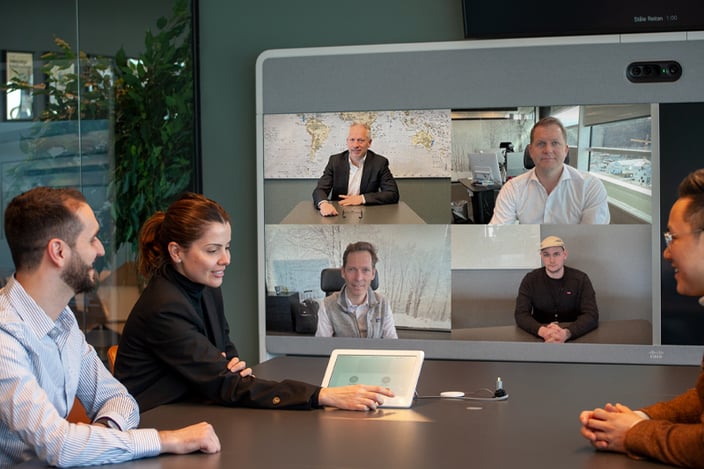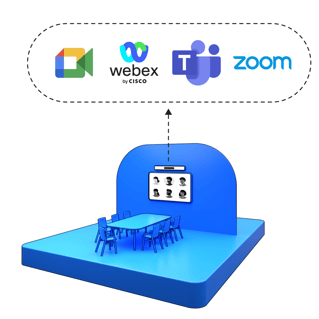It has become more important than ever to know what "hybrid work" is, how it will develop and what its impact on how we use meeting rooms actually is.

There are three safe predictions I can make on what lies ahead about the way we work. (1) Offices will never go back to full capacity, (2) they certainly won’t be the same as they were "pre-pandemic" and (3) hybrid working will be an important part of future work life.
Click here to learn how to optimize the use of your meeting rooms!
What’s all that fuss about hybrid working about?
Together with ‘furlough’ and ‘unprecedented, ‘hybrid working’ has to be one of the strangest buzz words to come up in the past couple of years. Everyone is talking about it but what does it actually mean? Well, in loose terms it means some people will be working from the office and some people will be working from home (and that you are able to do either when appropriate). In my opinion, however, this will look hugely different from one business to the next.
Why? Because ultimately people are at the heart of every business and every person has different comfort zones, emotions, and personal situations. Many of which will have changed during the pandemic. All these things must be taken into consideration when contemplating returning to an office (along with whether you can actually do your job from home, of course). That’s why it is impossible to make general predictions about exactly how hybrid working will look like.
How should we expect it to develop?
I am so glad that many businesses have opened their eyes and realized you can be equally or even more productive working from home. As we know, many would never have taken that leap of faith had they not been forced to. It’s such a positive change, but it's not for everyone. Some people have really struggled to work from their kitchen table and don’t have the space. Some don’t have the self-motivation to work from home. Others have simply not enjoyed it and need to be surrounded by ideas and the atmosphere that an office brings.
One thing I’m confident of: there won’t be only two options – to either stay at home or go to the office at all times. I don’t think it will be as clear cut as working in the office on set days either i.e., office Monday-Wednesday and from home Thursday and Friday. I think people will go in when it better suits them.
I expect office occupancy to be vastly different from one day to another and one business to the next. This will make it very difficult to ascertain how much seating is needed and in turn how many meeting rooms will be needed. Thankfully, we have a solution to this problem.
Meeting rooms still matter. How can we best leverage them?
Many businesses are still relying on data from calendars to determine the number of meetings taking place. However, this is often inaccurate. Synergy SKY has an embedded analytics platform that helps businesses determine meeting room utilisation, usage trends and prominent people count. Businesses can then assess whether the existing meeting rooms are fit for purpose (post covid) or whether they need more/less rooms, bigger or smaller rooms.
Would you be surprised to hear that in some of the businesses I am talking to right now, up to 80% of the meetings booked at the office are not taking place in the room booked? We can assume a large portion of these changed to a Teams, WebEx, or Zoom meeting with participants taking part at home or from their desk in the office. However, as your colleagues do start to return to the office and numbers slowly increase, video calls from your desk will not always be appropriate. You will probably find then that the meeting room will be essential for:
-
Confidential discussions where privacy is essential
-
The ability to include other colleagues in the discussion (office or home-based)
-
Better audio and video quality than from your laptop – suitable for a group of people
This need for agility and flexibility will mean you need the video in meeting rooms to be simple to use. Being able to communicate with home workers with ease is crucial. Just as easy as the click-to-join method everyone has become accustomed to from their laptop. Gone are the days where users will be bothered to dial a number or a long URL string to join a meeting. Synergy SKY has a solution for this that provides a simple and consistent method for scheduling and joining all videos whether they are scheduled on Zoom, Teams, WebEx, or BlueJeans.

To truly make meeting rooms work as efficiently as they possibly can, however, interoperability also needs to be accounted for. One key cause of delays in meetings after all has been the lack of true interoperability allowing any SIP-based endpoint to be connected to all Microsoft Teams meetings, which is something that Synergy SKY now also provides.
In sum, will hybrid working change how we relate to offices? Probably. Is it hard to make all-encompassing generalizations about how this will affect organizations? Sure. Is there something we can do to get the best out of our existing tools and have meetings that simply work? Absolutely.


A slightly different version of this article was originally published in AV Magazine.
Click here to read it in its entirety.




